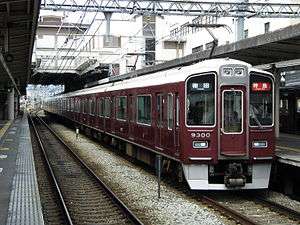Hankyu 8200 series
| Hankyu 8200 series | |
|---|---|
|
An 8200 series on a limited express service, May 2013 | |
| In service | 1995– |
| Manufacturer | Alna Kōki |
| Number built | 4 vehicles (2 sets) |
| Number in service | 4 vehicles (2 sets) |
| Formation | 2 cars per trainset |
| Operator(s) | Hankyu Railway |
| Depot(s) | Nishinomiya |
| Line(s) served | Hankyu Kobe Main Line |
| Specifications | |
| Car body construction | Aluminium alloy |
| Car length | 19,000 mm (62 ft 4 in) |
| Width | 2,750 mm (9 ft 0 in) |
| Height | 4,095 mm (13 ft 5.2 in) |
| Doors | 3 pairs per side |
| Maximum speed | 110 km/h (70 mph) |
| Traction system | Variable frequency (GTO) |
| Acceleration | 2.8 km/h/s |
| Electric system(s) | 1,500 V DC |
| Current collection method | Overhead catenary |
| Bogies | SS-139A, SS-039A |
| Braking system(s) |
Regenerative brake Electronically controlled pneumatic brakes |
| Safety system(s) | ATS |
| Coupling system | Shibata-Type |
| Multiple working | 7000 series, 8000 series, 9000 series |
| Track gauge | 1,435 mm (4 ft 8 1⁄2 in) |
The Hankyu 8200 series (阪急電鉄8200系) is an electric multiple unit (EMU) train type operated in Japan by the private railway operator Hankyu Railway since 1995.
Formations
As of 1 April 2015, the fleet consists of two two-car sets, formed as follows.[1]
| Designation | Mc1 | Tc |
|---|---|---|
| Numbering | 8200 | 8250 |
The "Mc1" cars are fitted with two single-arm pantographs.[1]
References
| Wikimedia Commons has media related to Hankyu 8200 series. |
This article is issued from Wikipedia - version of the 8/7/2015. The text is available under the Creative Commons Attribution/Share Alike but additional terms may apply for the media files.
